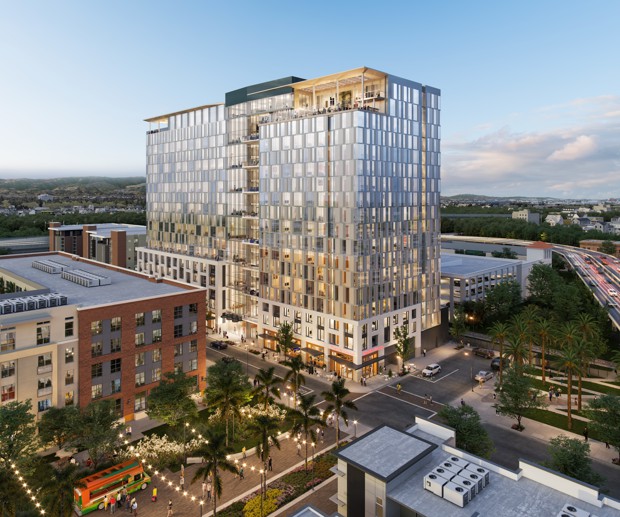By Sarah Holder, Citylab, June 7, 2019
“An 800-unit, 18-story ‘dorm for adults’ will help affordably house Silicon Valley’s booming workforce.
“The co-housing start-up Starcity is working to fill America’s housing-strapped cities with co-housing compounds. Since launching in 2016, the company has broken ground on seven developments in Los Angeles and San Francisco. In most Starcity buildings, renters get a furnished 130- to 220-square-foot bedroom, share a communal kitchen and living space, and get a range of Millennial-friendly amenities. Rents range from $1,400 to $2,400 a month.
“The company got the green light to start work on its biggest project — an 18-story building with 803 units in the heart of downtown San Jose. Just as industrial cities looked to SROs and flophouses to shelter their booming young urban workforce, Starcity is making buildings that can accommodate the live-work-play demands of a new labor class. As Curbed SF reported: ‘95 percent of the usable square footage in an SRO is renters’ rooms, with the remaining five percent mostly hallways. By comparison, a Starcity building is about 65 percent bedrooms, and 20 percent of the building is dedicated to communal spaces and kitchens.’

“High-density co-housing buildings aren’t hotels, and they’re not traditional multifamily apartments. Starcity had to work with the city to change local zoning codes, and the city agreed to create a new use category entirely for the project. After approval of the rezoning by the city council in February, ‘co-living’ became its own distinct land-use classification in April.
“Once slated to host a 300-unit multi-family complex, the land is now cleared to hold almost triple that occupancy.
“‘We struggle so greatly just to get a shovel in the ground to get housing in the city, because construction costs are so high right now,’ says San Jose Mayor Sam Liccardo. ‘The fact that the developer had an approach that could get housing built was a good enough signal to me that we should get any obstacles out of the way.’
“Besides creating a bespoke zoning category, San Jose swept away other barriers, including parking requirements (800 Millennials don’t need 800 parking spaces); and an inclusionary housing ordinance holds developers to building 15 percent affordable units or paying a per-unit fee.
“But ‘the units are not really affordable,’ reads a statement from SV@Home, a local affordable housing policy group. ‘They are not rent-restricted, and often charge rents well beyond the reach of lower-income households.’
“Bay Area renters seeking something more affordable could look to another Starcity development in San Francisco’s SoMa neighborhood, whose permit was also approved last week. Rents at this 270-room, 16-story building will start as low as $800 a month —’no easy feat in San Francisco.’ Half the units will be affordable for renters who make 80 percent of area median income or lower. This qualifies it for California’s SB35 program, which offers an expedited building timeline for these more affordable buildings.
“The San Jose mega-building will feature ‘vertical neighborhoods,’ where residential floors are linked not just by horizontal hallways but by two-story communal spaces, and terraces whose stairs interconnect. ‘This way, a broad array [of] residents from multiple floors can interact and engage with one another socially within the building’s various communal spaces.’
“Construction is set to start in the fall, with a late 2021 opening.
“‘If you look at successful cities across America, the best thing is if you’re going to create a tower or a tall building, make sure it has more than one use and that multiple types of people can enjoy and interact with that building,’ say Alex Shoor, co-founder of San Jose housing advocacy group CatalyzeSV. The closed corporate campuses that line Silicon Valley’s Highway 101 corridor are a mistake, he says: They separate employees from the cities they live in, stuff them with free snacks, and at the of the day send them back in cars to distant apartments.
“Future iterations of Starcity’s co-living model will make room for babies, joining family-friendly co-living start-ups like Kin, which feature shared playrooms and family kitchens in its developments.”
The above is an excerpt. Read the full article, with images, here.

